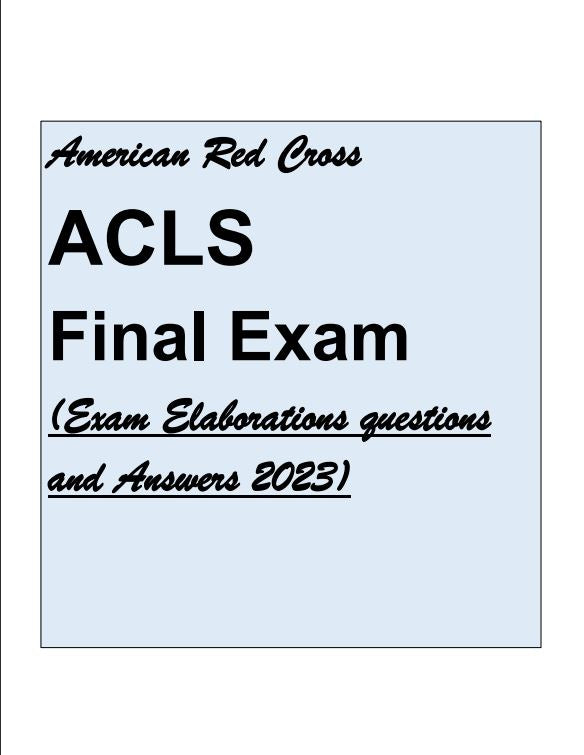American Red Cross ACLS Final Exam (Exam Elaborations questions and Answers 2023)
American Red Cross ACLS Final Exam (Exam Elaborations questions and Answers 2023)
Couldn't load pickup availability
. A patient is in cardiac arrest. The cardiac monitor shows asystole. In addition to
providing continuous high-quality CPR, what is the other priority intervention for this
patient?
Administering epinephrine as early as possible
2. A patient has experienced return of spontaneous circulation (ROSC) after cardiac
arrest. The healthcare team is conducting a secondary assessment to determine the
possible cause of the patient's cardiac arrest. Before the arrest, the patient exhibited
jugular venous distension, cyanosis, apnea and hyperresonance on percussion. The
patient was also difficult to ventilate during the response. The team would most likely
suspect which condition as the cause?
Tension Pneumothorax
3. A patient with suspected stroke arrives at the emergency department. The patient is
diagnosed with acute ischemic stroke and is a candidate for fibrinolytic therapy. To
achieve the best outcomes, this therapy should be initiated within what time frame?
Within 1 hour of patient's arrival.
4. A patient in the telemetry unit is receiving continuous cardiac monitoring. The patient
has a history of myocardial infarction. The patient's ECG rhythm strip is shown in the
following figure. The provider interprets this strip as indicating which arrhythmia?
Third-degree AV block
5. A 28-year-old pregnant patient who resides in transitional housing presents to the
emergency department with complaints of feeling feverish and very faint. The patient
tells the emergency nurse that she does not know when she became pregnant.
Upon palpation, the fundus is not at or above the umbilicus. The patient's condition
quickly deteriorates and she goes into cardiac arrest. If available and able to be
used without impeding or delaying the resuscitation effort, what diagnostic tool could
be used to guide decision-making in the care of this patient?
Point-of-care ultrasound
6. Cardiac monitoring indicates that a patient has a ventricular tachyarrhythmia. The
patient has a pulse and is not showing any signs of hemodynamic compromise. A
12-lead ECG reveals an irregular rhythm with QRS complexes greater than 0.12
second in duration. Which action would be appropriate at this time?
Consider an antiarrhythmic medication
Share

